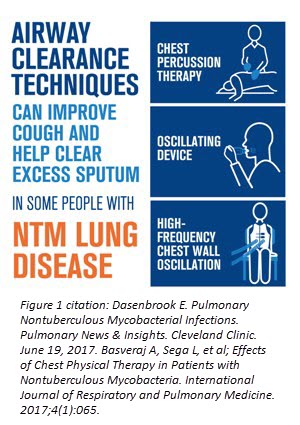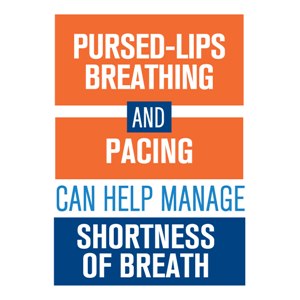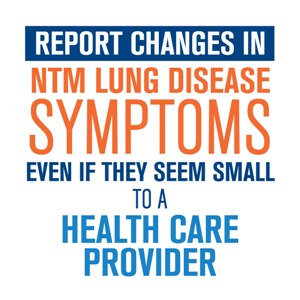This post was authored by Jane Martin, BA, CRT
This is the third in a series of four blog posts on nontuberculous mycobacterial (NTM) lung disease. Thank you to NTM lung disease patient, Diane L. Gregg, for sharing the patient perspectives in this post.
Experiences with NTM lung disease vary for each patient, and the information included in this blog post is not intended as medical advice. For more information about your specific situation, please consult your health care provider.
This article was updated on August 18, 2021.
In the first two blog posts in this series, we learned about NTM lung disease, what it has in common with COPD, what causes it, and how it is diagnosed.
Now let’s look at how NTM lung disease can be managed and treated.
When a person has been diagnosed with NTM lung disease, it is helpful for that individual and their health care provider to sit down and talk about options for management, including if treatment is needed. They can discuss potential risks and benefits, always keeping in mind the importance of the patient’s quality of life.1
Treatment
Always check with a health care provider before making any changes to an approved treatment plan.
The NTM Lung Disease Treatment Guidelines were created by leading scientific communities to provide doctors with recommendations for the treatment of NTM lung disease and are the globally recognized standard for the management of the condition. Depending on the type of infection, management typically includes a combination of various antibiotics, and the guidelines recommend a multidrug regimen of at least three antibiotics. This helps to prevent the bacteria from becoming resistant.2 It’s most helpful for health care providers and patients to work together to figure out which combination of medications will be the right option for them. Any treatment decision should include a discussion with you, the patient, that includes potential side effects of therapy, the possible benefits to taking the antibiotics, and the potential for recurrence or reinfection. The guidelines also recommend that doctors evaluate if the multidrug regimen is working after 6 months of treatment, as there may be other management options for those who aren’t responding to their treatment regimen.2
Longer-term antibiotic therapy may be an option. With this treatment method, there is close monitoring by the health care provider and ongoing communication between the health care provider and the patient.
*Sometimes a bacterium can develop a resistance to an antibiotic medication. When this happens, that bacterium is no longer killed or disabled by that specific medication.
Management
Always check with a health care provider before making any changes in activity or diet.

Some individuals with NTM lung disease have a cough that produces large amounts of sputum (when mucus is combined with germs and becomes inflamed, it is called "sputum").3 Airway clearance therapy can help. This therapy may include a nebulizer treatment with a bronchodilator or hypertonic saline (a strong, sterile solution of salt water) followed by some form of chest physical therapy.4
Chest physical therapy helps loosen sputum so it is easier to cough up and out of the lungs. There are a variety of chest physical therapy treatments, such as manual chest percussion therapy (tapping on the chest done by a respiratory or physical therapist or a trained caregiver), using a handheld (oscillating) device that vibrates the airways, or wearing a vest-like device that shakes the chest wall (high-frequency chest wall oscillation).5 Management for NTM lung disease may also include surgery in some cases.2
There are many things people with NTM lung disease can do to help stay as healthy as possible.
Reducing exposure to NTM bacteria
NTM bacteria is commonly found in soil and water in the environment. Even with successful treatment and management, individuals with NTM lung disease are at higher risk for reinfection. But, if they have an idea of where NTM bacteria is more likely to thrive, they can take steps to reduce how much of it is in their environment, including:
- Raising hot water temperature to 130°F (55°C).
- Using bacteriologic filters on taps and showerheads.
- Disinfecting the showerhead by submerging in household bleach for 30 minutes.
- Using a showerhead with large holes to reduce mist formation.
- Increasing the power of the bathroom exhaust.
- Avoiding inhaling dust when gardening.
- Moistening garden and potting soils.6
For more information on reducing exposure to NTM bacteria visit NTM Info & Research's website at www.NTMinfo.org.
Breathing techniques and pacing

Shortness of breath is a common symptom of NTM lung disease.7 Often, shortness of breath can be managed by using a special breathing technique, pursed-lips breathing. This can be taught by a respiratory, physical, or occupational therapist, or another trained health care professional. Pacing, a specific way of slowing down, can also help. If the shortness of breath does not go away or respond to these techniques, call your doctor or emergency services.
Exercise
It may be possible for people with NTM lung disease to exercise safely. A physical therapist may also help by setting up an exercise plan especially for each individual’s needs and limitations.
Patient perspective: I did not want to give up exercising because I was diagnosed with NTM lung disease. But I had to make changes in my routines based on what my body was telling me, and on my doctor’s advice. When I am really tired, I do as much as I am able. Over time, my stamina has improved. I always feel better after I exercise and realize exercise is an important part of feeling well.
Nutrition and hydration
Eating to maintain a healthy body weight and proper hydration are essential for staying as healthy as possible with NTM lung disease. An individual might have to gain weight, lose weight, or maintain a healthy body weight that is right for them.
We all need to take in fluids to survive and for our bodies to work properly. Fluid is essential for thinning sputum, which in turn helps clear it from the airways. Drinks such as alcohol, coffee, and tea can actually result in dehydration. For most people, the best fluid to drink is water.
Increasing fluid intake may be harmful to some individuals. It is advised to ask a health care provider before making any change.
Avoiding exacerbations (flare-ups)

As with other chronic health conditions, avoiding exacerbations, or flare-ups, is important. Individuals with NTM lung disease should learn how to watch for early warning signs like more shortness of breath, coughing up more sputum than usual, or a change in the color or thickness of sputum. Any of these signs and other changes – even small ones – in symptoms, may indicate the beginning of a flare-up. This should be discussed with a health care professional to prevent the symptoms from getting worse.
Patient perspective: You’re the expert of your body, and the information you relay to your medical team is extremely important; because you live in it and you're living with the disease so you can tell them what your experience feels like. Your doctors aren’t mind readers.
Sleep
Another way to help stay as healthy as possible is to get enough sleep. If an individual is not sleeping well, they should let their health care team know. If they get tired during the day, it is okay to take a nap.
Patient perspective: Be respectful of your body and listen to what it’s telling you.
Not smoking
Individuals with NTM lung disease should be honest with their health care team. This is especially important if those with NTM lung disease are still smoking. Continuing to smoke may make the condition worse.
Summary
Living with NTM lung disease may not be easy, but it is important to know that there are treatment and management options. As you can see, there are many things a person can do each day to stay as well as possible.
Watch for the last blog post in this series when we’ll talk about NTM lung disease research and resources for finding help and support. See also An interview with Diane Gregg, a person living with nontuberculous mycobacterial (NTM) lung disease.
This blog post is sponsored by Insmed Incorporated.
References
- Ryu YJ, Koh WJ, Daley CL. Diagnosis and Treatment of Nontuberculous Mycobacterial Lung Disease: Clinicians’ Perspectives. Tuberc Respir Dis (Seoul). 2016;79(2):74-84. https://doi.org/10.4046/trd.2016.79.2.74
- Daley CL, Iaccarino JM, Lange C, et al; Treatment of Nontuberculous Mycobacterial Pulmonary Disease: An Official ATS/ERS/ESCMID/IDSA Clinical Practice Guideline. Clinical Infectious Diseases. 2020; 71(4): e1-e36. https://academic.oup.com/cid/article/71/4/e1/5867961
- Voynow JA, Rubin BK. Mucins, Mucus, and Sputum. CHEST 2009;135:505-512. https://www.sciencedirect.com/science/article/abs/pii/S0012369209601422
- Dasenbrook E. Pulmonary Nontuberculous Mycobacterial Infections: A diagnostic and therapeutic challenge. Pulmonary News and Insight. 2017.
- Basveraj A, Sega L, et al; Effects of Chest Physical Therapy in Patients with Nontuberculous Mycobacteria. International Journal of Respiratory Pulmonary Medicine. 2017;4(1):065. https://www.ncbi.nlm.nih.gov/pmc/articles/PMC5552049/
- Falkinham JO III. Environmental sources of nontuberculous mycobacteria. Clin Chest Med. 2015;36(1):35-41. https://www.chestmed.theclinics.com/article/S0272-5231(14)00106-3/abstract
- Young JD, Balagopal A, Reddy NS, Schlesinger LS. Differentiating colonization from infection can be difficult. Nontuberculous mycobacterial infections: Diagnosis and treatment. J Respir Dis. 2007;28(1):7- https://www.patientcareonline.com/view/differentiating-colonization-infection-can-be-difficult-nontuberculous-mycobacterial-infections